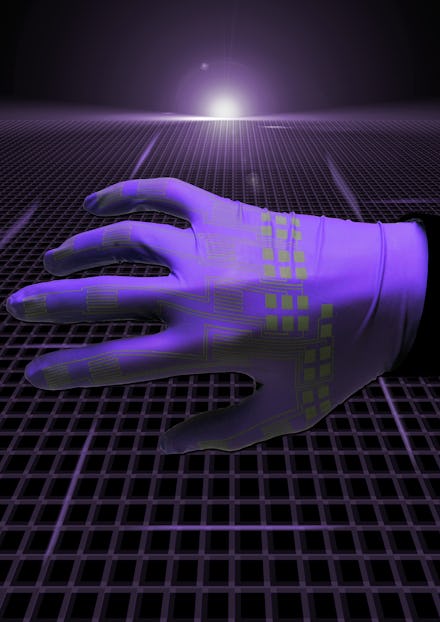Engineers Have Created the Future of Liquid Robots You Can Make on Desktop Printers

A team of engineers in Indiana have developed liquid-metal circuits that can be used to build soft robots — in other words, super pliable circuits that could be molded into the shape of your skin. Not only that, but this material of the future can be produced en masse from an inkjet printer.
While the technology was initially developed to be used in the context of fabric, like clothing to monitor body position and help with preventing injury, the applications for pliable, deformable circuitry have much bolder uses — like soft exoskeletons and search-and-rescue robots.
"A soft search-and-rescue robot would be robust and deformable, allowing it to squeeze through cracks and crevices to aid in natural disasters," Rebecca Kramer, assistant professor of mechanical engineering at Purdue University, who, along with researchers John William Boley and Edward White, co-authored the upcoming paper "Mechanically Sintered Gallium-Indium Nanoparticles," told Mic.
"For example, a soft robot could navigate the rubble of a collapsed building in order to identity resources and survivors that may be trapped underneath."
How it works: Liquid metal on its own is too thick to run through a typical desktop printer. But the research team found that if they combine it with an alcohol like ethanol, the liquid metal, which is mostly gallium instead of dangerous mercury, can be broken down to tiny nanoparticles using sound waves, making the metal fine enough to put through a regular inkjet printer nozzle. In other words, metal is turned into regular ink — but ink that can build robots.
Running the ink through a printer, instead of doing it by hand, means printing can be done quickly, often, and in abundance, making testing much faster and opening the door for mass production and manufacturing down the line.
"This means we can pursue sensory fabrics that will give you feedback on your pose," Kramer told Mic. "One example might be, say, you're in a lunge position and your knee goes over your ankle. We can sense and communicate that to you, allowing you to correct your pose to reduce the risk of injury."
What else can it do? The original purpose is promising in its own right. Being able to closely monitor a body's more injury-causing movements without having to spend a day at a physical therapy office is a major development in the field.
But the ability to manufacture soft robotics, when combined with other technologies, could open the door to a future that was otherwise struck in the warehouses of Hollywood.
That research is the next step. And a February article from the Indiana Economic Digest quoting Kramer suggests how far that could go.
"The Terminator 2 blob — where it's a liquid metal and then it coalesces into the robot, and then it performs some sort of task, and then it breaks down again — it's my dream," Kramer told Indiana Economic Digest. "We're going to build that; we're going to build the Terminator 2 robot."
Kramer elaborated for Mic: "We're currently working on reconfigurability with liquid metal, which would mean we could change the function of the metal on-demand," she says. The Terminator 2 robot "isn't going to happen tomorrow, but I think the idea of reconfiguring the shape and function of liquid metal is very feasible."
The more practical science-fiction application may be possible much sooner, in the form of inflatable, easily compactable, extremely helpful robots, like Baymax from Disney's Big Hero 6.
"We're working on a project with NASA for which we're building soft exploratory robots," Kramer said. "Being soft in unstructured environments and unexplored terrains gives the robot robust advantages, like surviving repeated impacts or falls — traumas a typical robot might not be able to survive."
As the printing technology updates, the scale of printing becomes almost infinite, like the applications, which run the gamut from body-hugging, soft exoskeletons to clothing that can be used to control video games. And while the concept is only scratching the surface of the technology — the research paper won't be published in the journal Advanced Materials until April 18 — it shines a bright light on what becomes possible when you can make robots right in your home printer.